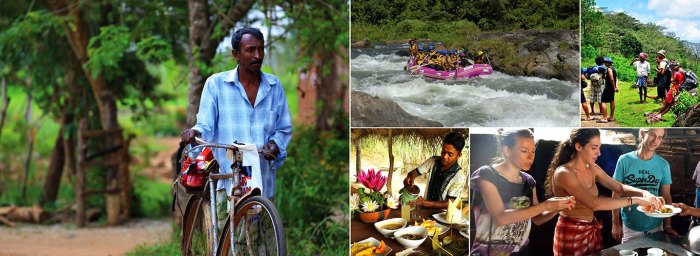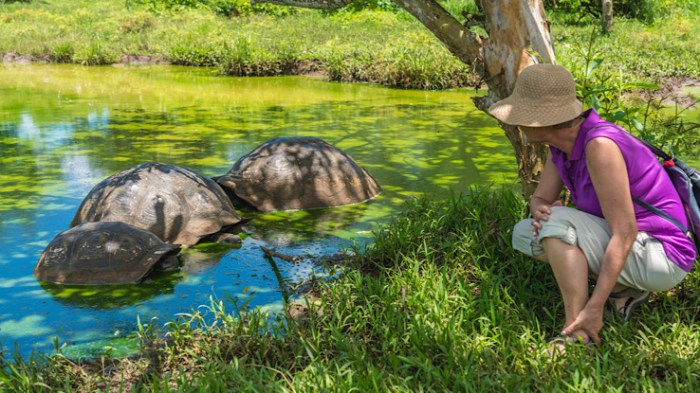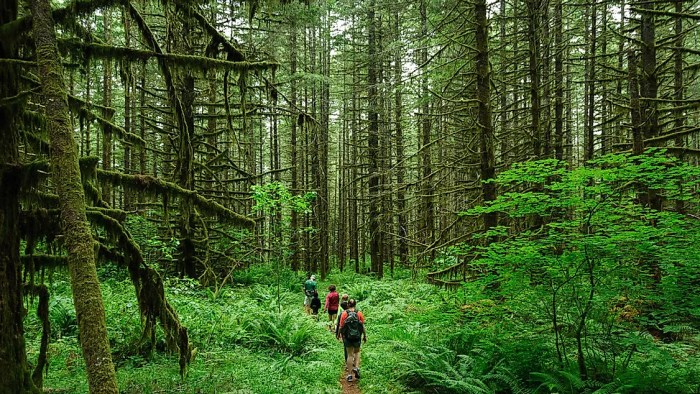Ecotourism Examples A Diverse Approach
Ecotourism examples showcase the diverse and engaging ways to experience nature responsibly. From exploring unique destinations to supporting local communities, ecotourism offers a range of activities and experiences. This exploration delves into the core principles, types, destinations, and sustainable practices of ecotourism, highlighting its potential for conservation and community development.
The variety of ecotourism activities, from wildlife safaris to community-based tours, reflects the unique characteristics of different regions. Successful case studies illustrate the positive impacts on both the environment and local economies. Furthermore, the discussion will highlight sustainable practices, addressing the critical role of eco-friendly transportation, waste management, and responsible tourism.
Defining Ecotourism
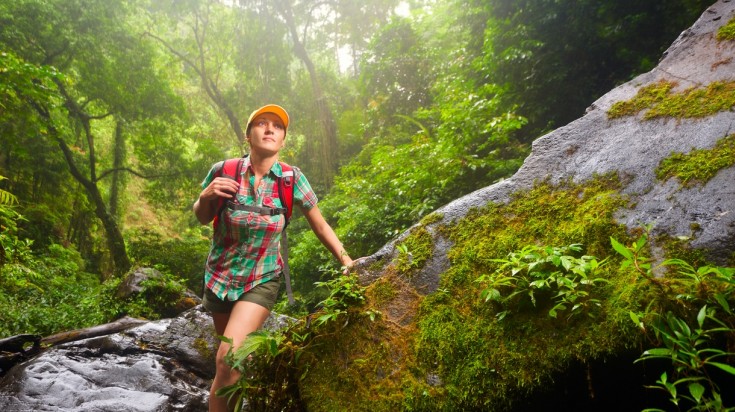
Ecotourism is a rapidly growing sector of the travel industry, attracting environmentally conscious travellers. It’s more than just a vacation; it’s a journey with a purpose. This section delves into the core characteristics of ecotourism, its historical evolution, underlying principles, and its distinction from other forms of tourism.
Definition of Ecotourism
Ecotourism is a form of tourism that involves visiting fragile, pristine, and undisturbed natural environments. It is specifically designed to be environmentally sustainable, preserving the ecological integrity of the destinations while benefiting local communities. A key characteristic is minimizing negative impacts on the environment and promoting responsible travel practices. This includes respecting local cultures, contributing to the conservation efforts, and supporting local economies.
Historical Context of Ecotourism Development
The concept of ecotourism emerged in the late 20th century as a response to the growing awareness of environmental issues and the need for more sustainable forms of travel. Early proponents recognized the potential for tourism to drive conservation efforts and support local communities. The rise of environmental consciousness in the public and the increasing popularity of nature-based activities were pivotal factors.
Principles and Ethical Considerations of Ecotourism
Ecotourism is built upon several core principles:
- Minimizing environmental impact: This includes reducing waste, conserving water and energy, and adopting sustainable transportation methods. For instance, using public transport or cycling instead of private vehicles during tours.
- Supporting local communities: Ecotourism initiatives should aim to provide economic benefits to local people, enabling them to participate in the tourism industry and maintain their traditional way of life.
- Respecting local cultures: Tourists are expected to be respectful of local customs, traditions, and beliefs. This involves learning about local cultures and interacting with locals in a culturally sensitive manner.
- Promoting conservation: Ecotourism should contribute to the conservation of natural resources and biodiversity. This can be achieved by supporting protected areas and wildlife conservation programs.
Differences Between Ecotourism and Other Forms of Tourism
Ecotourism differs significantly from other forms of tourism, primarily in its emphasis on environmental sustainability and community development. Mass tourism, for example, often focuses on maximizing profit and visitor numbers, potentially leading to environmental damage and exploitation of local communities. Other forms of tourism might prioritize specific interests, such as adventure tourism or cultural tourism, without necessarily aligning with the environmental sustainability and community benefit goals of ecotourism.
Comparison of Ecotourism and Mass Tourism
| Feature | Ecotourism | Mass Tourism |
|---|---|---|
| Environmental Impact | Minimizes environmental damage, promotes conservation | Often leads to pollution, habitat destruction, and resource depletion |
| Economic Impact | Benefits local communities, supports sustainable livelihoods | May lead to exploitation of local resources and low wages for workers |
| Cultural Impact | Respects and promotes local cultures | May lead to cultural homogenization and loss of traditions |
| Visitor Numbers | Generally, fewer visitors, focusing on quality experiences | Large numbers of visitors, leading to overcrowding and strain on resources |
| Focus | Nature-based experiences, conservation, and community development | Convenience, entertainment, and recreation |
Types of Ecotourism Activities
Ecotourism encompasses a wide range of activities, all centered around experiencing nature responsibly and sustainably. It goes beyond simply observing wildlife; it fosters a deeper connection with the environment and the local communities that depend on it. This approach is crucial for preserving natural resources and promoting economic development in harmony with the environment.
Categorization of Ecotourism Activities
Ecotourism activities are often categorized by the location or the specific activity undertaken. This allows for a more focused and impactful experience for tourists, as well as a clearer understanding of the environmental and social benefits. Different locations offer varying opportunities for interaction with nature, from exploring rainforests to hiking through mountains.
Ecotourism Activities by Location
Various destinations offer unique ecotourism experiences. Tropical rainforests, with their biodiversity, are popular for wildlife viewing, birdwatching, and jungle treks. Mountainous regions, renowned for their scenic beauty, attract hikers, climbers, and those seeking opportunities for cultural immersion. Coastal areas provide opportunities for snorkeling, diving, and whale watching, fostering an appreciation for marine ecosystems.
Examples of Ecotourism Activities in Different Regions
In Costa Rica, ecotourism activities include rainforest canopy tours, ziplining through the jungle, and spotting exotic birds. The Galapagos Islands offer opportunities for observing unique wildlife like giant tortoises and marine iguanas. In the Himalayas, treks through stunning landscapes, coupled with cultural immersion, are popular ecotourism activities. These experiences highlight the diversity of ecotourism opportunities across the globe.
Eco-Lodges and Sustainable Accommodations
Eco-lodges are becoming increasingly popular as a sustainable accommodation option. These lodges are designed to minimize their environmental impact, employing sustainable practices for construction, waste management, and energy use. For example, some lodges use solar energy, recycle waste, and support local communities. These eco-lodges often provide a comfortable and luxurious stay while minimizing their footprint. Examples include lodges built with locally sourced materials or those using rainwater harvesting systems, reflecting a dedication to responsible environmental stewardship.
Examples of Eco-Lodges and Sustainable Accommodations
The Rainforest Lodge in Costa Rica uses recycled materials and solar power. The Avani Eco Resort in the Philippines is known for its sustainable practices and community engagement. These examples demonstrate how eco-lodges can integrate sustainable practices into their design and operation, providing an experience that balances comfort with conservation.
Role of Local Communities in Ecotourism Initiatives
Ecotourism initiatives should prioritize the involvement of local communities. Local communities possess valuable knowledge about the environment and its resources, and their participation ensures that the benefits of ecotourism are shared equitably. This involvement can lead to improved livelihoods for local people, preserving cultural heritage, and strengthening community pride. Local guides, for instance, are vital to the success of ecotourism initiatives.
Table of Ecotourism Activities and Target Audiences
| Type of Ecotourism Activity | Target Audience | Description |
|---|---|---|
| Wildlife Viewing | Nature enthusiasts, photographers, and families | Observing and appreciating diverse wildlife in their natural habitat. |
| Hiking and Trekking | Adventurous individuals, fitness enthusiasts, and nature lovers | Exploring scenic landscapes on foot, often involving overnight stays in remote areas. |
| Cultural Immersion | History buffs, anthropologists, and those interested in local traditions | Experiencing the cultural heritage and traditions of local communities. |
| Birdwatching | Nature enthusiasts, birdwatchers, photographers | Identifying and observing various species of birds in their natural habitats. |
| Snorkeling and Diving | Water enthusiasts, marine life enthusiasts, and families | Exploring underwater ecosystems and observing marine life. |
Sustainable Practices in Ecotourism
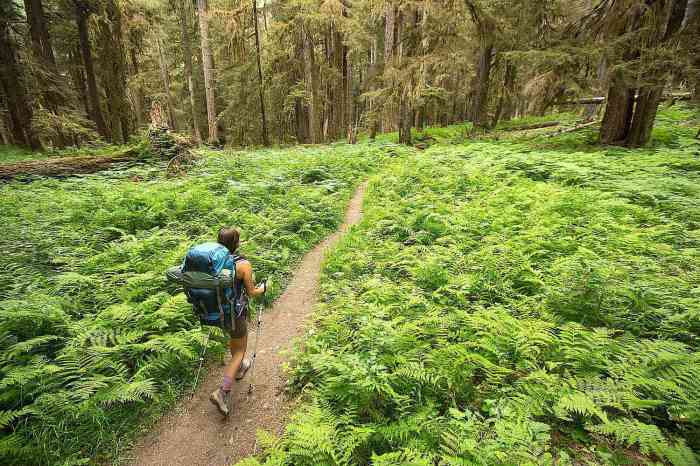
Source: thoughtco.com
Ecotourism, by its very nature, should prioritize environmental conservation. Sustainable practices are crucial to ensuring that the economic benefits of ecotourism do not come at the cost of the natural resources and ecosystems it depends. This involves careful planning and implementation of strategies that minimize the negative impacts of tourism while maximizing its positive effects.
Eco-friendly practices are essential for the long-term viability of ecotourism destinations. By adopting these strategies, operators and visitors alike can contribute to the preservation of fragile ecosystems and the well-being of local communities.
Importance of Sustainable Practices
Sustainable practices in ecotourism are vital for the long-term health of both the environment and the local communities. They ensure that the benefits of tourism are distributed equitably and that the natural resources are protected for future generations. Sustainable tourism minimizes the negative impacts of human activity on the environment, promoting responsible resource use and minimizing pollution.
Eco-Friendly Transportation Methods
Choosing eco-friendly transportation methods is paramount for minimizing the carbon footprint of ecotourism activities. These methods often include using electric or hybrid vehicles, opting for cycling or walking whenever possible, and supporting public transportation systems. A commitment to reduced emissions contributes to mitigating climate change and preserving air quality. For example, some ecotourism operators in national parks are using electric golf carts for transporting visitors within the park, reducing noise and exhaust emissions.
Waste Management Strategies
Effective waste management is essential for maintaining the pristine environment of ecotourism destinations. Proper waste segregation, recycling programs, and composting initiatives are vital for reducing landfill waste and minimizing environmental contamination. This includes educating tourists about responsible waste disposal practices. Implementing a comprehensive waste management system, involving separate bins for recyclables, compostables, and general waste, is a key element of sustainable tourism.
Responsible Tourism and Natural Resource Preservation
Responsible tourism plays a critical role in preserving natural resources. It encourages visitors to respect the environment, minimizing their impact and supporting local conservation efforts. This includes avoiding activities that could damage fragile ecosystems, respecting wildlife, and participating in initiatives that protect natural resources. Responsible ecotourism practices, like promoting sustainable harvesting of local produce and discouraging the purchase of souvenirs made from endangered species, support the preservation of natural resources.
Minimizing Environmental Impact
Minimizing environmental impact is central to sustainable ecotourism. Strategies include reducing energy consumption, minimizing water usage, and implementing efficient water and energy-saving technologies. Using renewable energy sources, such as solar panels, is another crucial element of minimizing environmental impact. For instance, many eco-lodges are powered by solar energy to reduce reliance on fossil fuels.
Best Practices for Sustainable Ecotourism
| Category | Best Practice | Description |
|---|---|---|
| Transportation | Utilize electric or hybrid vehicles | Reduces emissions and noise pollution. |
| Waste Management | Implement comprehensive waste segregation | Minimizes landfill waste and contamination. |
| Energy Consumption | Use renewable energy sources | Reduces reliance on fossil fuels and promotes sustainability. |
| Water Usage | Implement efficient water-saving technologies | Conserves water resources in the region. |
| Visitor Education | Educate tourists about responsible behavior | Encourages respect for the environment and local culture. |
| Community Involvement | Support local communities | Ensures fair distribution of benefits and promotes local empowerment. |
Ecotourism and Community Development: Ecotourism Examples
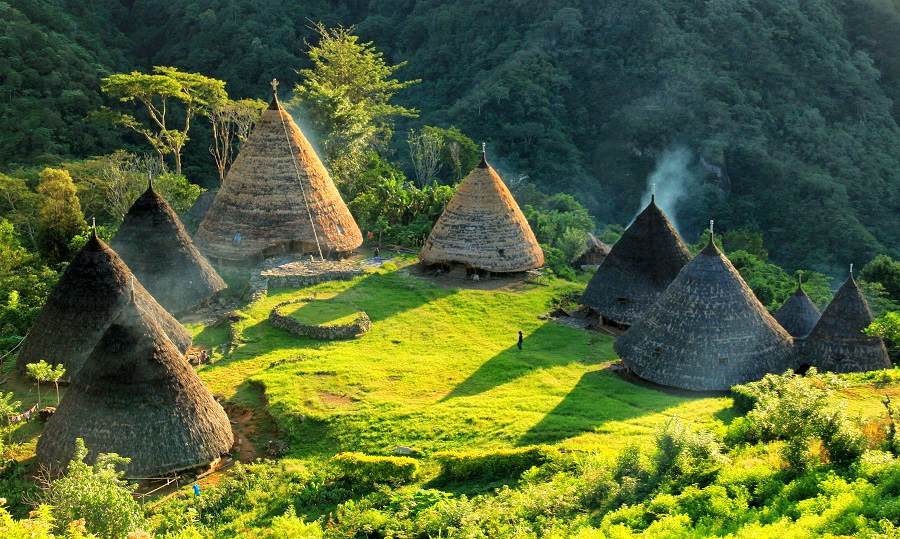
Ecotourism, when implemented responsibly, can significantly benefit local communities, fostering economic growth and preserving cultural heritage. This positive impact hinges on community involvement and equitable distribution of the economic gains. By prioritizing local participation, ecotourism can empower communities and enhance their livelihoods.
Ecotourism’s potential to uplift communities is evident in numerous initiatives worldwide. These projects not only improve the economic standing of residents but also strengthen their cultural identity and environmental stewardship. Fair wages and equitable economic distribution are crucial components of successful ecotourism ventures. Recognizing and respecting local traditions and customs is essential for the long-term sustainability of ecotourism.
Positive Impacts on Local Communities
Ecotourism initiatives can bring substantial economic benefits to local communities, leading to job creation, improved infrastructure, and increased income levels. These improvements contribute to a higher quality of life for residents and enhance their overall well-being. Moreover, the preservation of cultural heritage and traditions is often a direct outcome of ecotourism, as communities see the value in maintaining their unique identities.
Examples of Community-Based Ecotourism Initiatives
Numerous examples illustrate the success of community-based ecotourism projects. One prominent example is the involvement of local communities in guiding tourists through national parks and protected areas. Another successful model is the establishment of community-owned lodges and homestays, where tourists directly interact with local families, learning about their culture and contributing to their income. The establishment of sustainable businesses, such as locally-owned craft shops and restaurants, further reinforces the economic empowerment of local people.
Stories of Empowerment
Stories of community empowerment through ecotourism abound. In one case, a remote village in Costa Rica transformed its traditional agricultural practices by introducing sustainable ecotourism initiatives, creating employment opportunities, and boosting the local economy. The increase in income enabled the village to invest in improved healthcare and education facilities, significantly improving the quality of life for residents. Similarly, in Nepal, local communities have benefited from establishing eco-lodges, generating employment and preserving their cultural heritage. These stories demonstrate the power of ecotourism in fostering sustainable development and community empowerment.
Importance of Fair Wages and Economic Benefits
Ensuring fair wages and equitable economic benefits for local people is paramount in ecotourism. This includes providing opportunities for local participation in decision-making processes and ensuring that the profits generated by ecotourism are distributed fairly among community members. This ensures that ecotourism initiatives do not merely benefit external stakeholders but also directly contribute to the well-being of residents.
Role of Local Cultural Preservation in Ecotourism
Ecotourism should actively contribute to the preservation of local culture. This includes providing opportunities for cultural exchange and education, ensuring that tourists understand and respect local traditions and customs, and supporting the maintenance of cultural heritage sites. Local artisans and craftspeople should be involved in the tourism experience, allowing them to showcase their skills and earn a living.
Benefits of Ecotourism for Local Economies
| Benefit | Description |
|---|---|
| Increased Employment | Ecotourism often creates new jobs in guiding, hospitality, and related sectors. |
| Improved Infrastructure | Tourism spending can lead to upgrades in transportation, communication, and other essential infrastructure. |
| Enhanced Income Levels | Ecotourism can significantly increase household income for local communities. |
| Cultural Preservation | Ecotourism can support the preservation of local traditions and customs. |
| Environmental Protection | Ecotourism can incentivize environmental conservation by creating economic incentives for sustainable practices. |
Challenges and Opportunities in Ecotourism
Ecotourism, while offering significant benefits for conservation and community development, faces numerous challenges. Understanding these hurdles is crucial for sustainable growth and responsible management. Addressing these obstacles requires proactive planning and a nuanced understanding of the interplay between environmental factors, economic considerations, and social impacts.
Major Challenges Facing Ecotourism Development
Ecotourism faces several hurdles, impacting its ability to fulfill its potential. These obstacles range from environmental pressures to logistical complexities and economic disparities. Successfully navigating these challenges is essential for the continued success of ecotourism initiatives.
- Overtourism and Infrastructure Strain: Ecotourism destinations, particularly those popular for their natural beauty, often experience increased visitor numbers exceeding the carrying capacity of the environment. This leads to strain on local infrastructure, resources, and the overall quality of the visitor experience. For instance, overcrowding at popular wildlife viewing sites can disrupt natural behaviors and damage habitats.
- Environmental Degradation: Inadequate waste management, unsustainable transportation, and unregulated activities can severely degrade the environment, undermining the very essence of ecotourism. This can manifest as pollution, habitat destruction, and loss of biodiversity.
- Climate Change Impacts: Rising temperatures, altered precipitation patterns, and increased frequency of extreme weather events pose significant threats to ecotourism destinations. Coral bleaching in tropical marine environments, for example, can decimate crucial ecosystems vital for the tourism experience.
- Lack of Skilled Personnel and Resources: Effective ecotourism requires skilled personnel knowledgeable in environmental conservation, sustainable practices, and visitor management. A lack of trained professionals and sufficient resources can lead to ineffective management and potentially negative impacts.
- Community Involvement and Benefit Sharing: Ecotourism must equitably share benefits with local communities. Failure to do so can lead to resentment, conflict, and unsustainable practices.
Threats to Ecotourism Destinations
Many factors threaten ecotourism destinations, jeopardizing the delicate balance of natural resources and local communities. Recognizing and mitigating these threats is vital for ensuring the long-term viability of ecotourism.
- Climate Change: The effects of climate change, including rising sea levels, altered precipitation patterns, and more frequent extreme weather events, pose a serious threat to ecotourism destinations. Coastal erosion, for example, can damage infrastructure and displace communities dependent on tourism.
- Natural Disasters: Natural disasters, such as hurricanes, floods, and wildfires, can inflict severe damage on ecotourism destinations, disrupting infrastructure, impacting local communities, and harming natural environments.
- Pollution: Pollution from various sources, including air, water, and land, can negatively affect ecotourism destinations. Water pollution from agricultural runoff or industrial discharge can harm aquatic ecosystems and negatively impact tourism activities reliant on healthy aquatic environments.
Opportunities for Biodiversity Conservation, Ecotourism examples
Ecotourism offers valuable opportunities for biodiversity conservation, moving beyond simply supporting conservation efforts. It fosters a sense of responsibility and stewardship among tourists and can generate funds directly supporting these efforts.
- Funding Conservation Efforts: Ecotourism can generate revenue that directly supports conservation projects, such as habitat restoration, wildlife protection, and anti-poaching initiatives. The revenue generated from park entry fees, for example, can fund vital conservation efforts.
- Raising Environmental Awareness: Experiencing nature firsthand through ecotourism can foster a deeper understanding and appreciation for biodiversity. This heightened awareness can motivate individuals to adopt more sustainable practices in their daily lives.
Potential of Ecotourism to Enhance Environmental Awareness
Ecotourism has the potential to significantly enhance environmental awareness among tourists and communities. This heightened understanding can lead to responsible behavior and support for conservation.
- Promoting Sustainable Practices: Ecotourism encourages visitors to adopt sustainable practices, such as reducing their carbon footprint, respecting wildlife, and conserving resources. This approach can contribute to a more sustainable way of life for all.
Need for Responsible Planning and Management in Ecotourism
Responsible planning and management are essential for the success and sustainability of ecotourism initiatives. These measures ensure the long-term viability of the destinations and the well-being of local communities.
Potential Challenges and Solutions in Ecotourism
| Challenge | Potential Solution |
|---|---|
| Overtourism | Implementing visitor quotas, promoting off-season travel, and diversifying activities to reduce pressure on peak seasons. |
| Environmental Degradation | Enforcing strict environmental regulations, promoting waste management programs, and investing in sustainable transportation options. |
| Climate Change Impacts | Developing climate-resilient infrastructure, diversifying tourism activities, and supporting research and adaptation strategies. |
| Lack of Skilled Personnel | Investing in training programs for local communities and developing partnerships with conservation organizations. |
| Community Involvement | Establishing transparent mechanisms for benefit sharing, involving local communities in decision-making processes, and promoting fair wages. |
Ecotourism and the Future
Ecotourism, a rapidly evolving sector, is poised to play an increasingly important role in the global landscape. The future of ecotourism is intricately linked to sustainability, technological advancements, and the growing desire for immersive nature experiences. Understanding these interconnected factors is crucial for ensuring ecotourism’s continued success and positive impact.
The future of ecotourism is shaped by a blend of environmental consciousness, technological progress, and the desire for meaningful connections with nature. This evolution necessitates adaptation to climate change, fostering innovation in travel experiences, and prioritizing the well-being of both tourists and local communities. This dynamic environment demands a proactive approach to address the challenges and capitalize on the opportunities that lie ahead.
Future Trends in Ecotourism
Ecotourism is experiencing a shift towards more personalized and immersive experiences. This includes bespoke itineraries tailored to individual interests, fostering deeper engagement with local cultures and traditions, and providing opportunities for unique interactions with wildlife in natural habitats. These trends reflect a growing desire for authentic and enriching travel experiences, rather than simply visiting popular tourist destinations. Moreover, an emphasis on responsible travel practices and community engagement is becoming paramount.
Emerging Technologies Supporting Ecotourism

Technological advancements offer exciting possibilities for enhancing the ecotourism experience while minimizing environmental impact. Virtual reality (VR) and augmented reality (AR) technologies can transport visitors to remote locations, providing interactive and immersive experiences without physical travel. This can reduce the environmental burden of traditional tourism while expanding accessibility to diverse ecosystems. Furthermore, GPS-enabled tracking systems and environmental monitoring tools can facilitate sustainable practices, enhance wildlife conservation efforts, and improve resource management.
Adapting to Climate Change in Ecotourism
Climate change presents significant challenges for ecotourism. Rising sea levels, extreme weather events, and changing wildlife patterns necessitate proactive measures for adaptation. Ecotourism businesses must adopt strategies to mitigate these impacts, such as relocating facilities to safer locations, diversifying offerings to accommodate changing ecosystems, and investing in climate-resilient infrastructure. Examples of such adaptations include shifting tour routes to avoid affected areas or incorporating climate change education into tour programs.
Fostering Deeper Connections with Nature
Ecotourism provides unique opportunities to foster deeper connections with nature. By engaging with local communities, participating in conservation initiatives, and experiencing natural landscapes firsthand, tourists can develop a greater appreciation for the environment. This can translate into a stronger commitment to environmental stewardship and support for conservation efforts. For instance, citizen science programs allow tourists to participate directly in data collection and research, fostering a sense of ownership and responsibility.
Ecotourism’s Role in Promoting Global Sustainability
Ecotourism plays a vital role in promoting global sustainability. By generating revenue for local communities, supporting conservation efforts, and raising awareness about environmental issues, ecotourism can contribute significantly to the preservation of biodiversity and cultural heritage. This positive impact is achieved through responsible practices, community involvement, and the implementation of sustainable development strategies. By prioritizing environmental protection, ecotourism can create a positive feedback loop, where tourists contribute to the preservation of natural resources while also experiencing the benefits of a healthy environment.
Potential Future Directions and Developments in Ecotourism
| Future Direction | Description |
|---|---|
| Personalized Experiences | Tailored itineraries based on individual interests, including niche experiences like wildlife photography or birdwatching. |
| Technology Integration | Utilization of VR/AR for immersive experiences, GPS tracking for wildlife monitoring, and data analytics for sustainable management. |
| Climate Change Adaptation | Developing resilient infrastructure, diversifying tour offerings, and integrating climate change education into programs. |
| Community Empowerment | Promoting local involvement, supporting sustainable livelihoods, and fostering cultural exchange. |
| Sustainable Practices | Minimizing environmental impact, reducing waste, and supporting eco-friendly accommodations and transportation. |
Conclusive Thoughts
In conclusion, ecotourism examples offer a compelling case for responsible travel. By combining adventure with environmental consciousness, ecotourism has the potential to transform how we interact with nature and support local communities. The challenges, though significant, are matched by opportunities for innovation and responsible planning, ensuring a sustainable future for both tourists and the destinations they visit.
